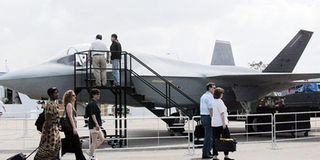It is the era of ‘you strike me and I will hit back faster’

In this file photo dated February 24, 2002 shows exhibitors walking past the US F-35 jet fighter displayed in front of the exhibition hall for the 11th Asian Aerospace exhibition in Singapore. PHOTO | ROSLANRAHMAN
What you need to know:
- Some nations are already in a “just-in-case-you-do mode” and are making preparations. Most notable are the United States and China. Media reports are both Russia and India are in the game, too.
- Generally little is often publicly known about how weapons being developed work.
Those who might think that globalisation and the inter-dependence of nations that has come with it portend an end to uncertainties of “assured mutual destruction” of yore had better think again.
Some nations are already in a “just-in-case-you-do mode” and are making preparations. Most notable are the United States and China. Media reports are both Russia and India are in the game, too.
The “game” is development, so far, of a weapon that would travel at speeds between Mach 5 to Mach 10. That’s between five and ten times the speed of sound respectively.
A week today, US military at missile launching range in Alaska destroyed an Advanced Hypersonic Weapon, AVW, four seconds after takeoff. That’s because controllers detected problems with control systems. Maureen Schumann of the US Department of Defence was quoted as saying there were no injuries.
The AVW is part of a programme to develop technologies and weapons that will form what the Washington Free Beacon newspaper said would be Pentagon’s Prompt Global Strike initiative.
The destroyed weapon was planned to travel at Match 5. That’s 5,600 km per hour. Launched near a town called Kodiak, the weapon was aimed at Kwajalein Atoll in the South Pacific. That’s a distance of 3,817 km in less than an hour’s flight.
Although there was no publicly pronounced disappointment, there certainly couldn’t have been smiles. After all, the first test of a similar weapon from Hawaii to Kwajalein last November went just fine.
Additionally, as Flight Global noted, “The weapon is the most promising of several technologies aimed at delivering a conventional warhead from US soil anywhere in the world within an hour of strike authorization.” Obviously, as the destruction would indicate, little progress had been made.
EXPLODED AFTER LAUNCH
By a co-incident, an interesting one, the Kodiak destruction came nearly three weeks after a similar Chinese weapon exploded shortly after launch. The South China Morning Post reported the Chinese hypersonic vehicle was launched August 7.
As is the case with the US, the first Chinese test of the weapon the Pentagon has dubbed WU-14, on January 9, was successful, the Post reported the National Defence Ministry saying. Reportedly, the Chinese vehicle is designed to travel at Mach 10, about 12,288 km per hour.
Generally little is often publicly known about how weapons being developed work. However, an analyst with the US Air Force National Air and Space Intelligence Centre, has told a congressional hearing the strike vehicle is “basically a ballistic missile-launched system that gets the payload fast and high, pitches over, dives to hypersonic speed, and then basically just glides to the target.”
Advantages are that the high speed increases ability to defeat counter measures and existing strategic missile defence systems.
Officially, the US says its weapon is for striking targets with limited strike windows. Chinese officialdom remains mum. However, Mr Xudong Wang, a satellite adviser to China’s central government, told the South China Morning post existing Chinese missile capabilities aren’t a match to US shields, making hypersonic weapons necessary.
Development of new weapons has a domino effect among nations. Well, an era of “You strike me and I will hit back faster” has began and with it uncertainties.




